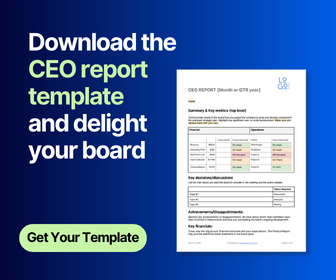The relationship between the CEO and the board of directors
Many people know that a company CEO meets with the board of directors every month. But very few know exactly what the CEO and the board need to talk about. Questions loom about how much detail is too much when it comes to sharing company performance yet uncertainty also often exists on the other side around what the board actually wants to hear from the CEO.
Broadly speaking, though, board members need to know enough about an organisation so that they can help. And without this effective and transparent communication, problems will very likely arise. For example, an ill-informed board may not be able to carry out all the essential tasks and make effective decisions, or there may be feelings of incompetence regarding each other.
However, the truth is, there is no simple answer to this question as what the board needs to hear from the CEO largely depends on their primary goals and tasks.
In previous BoardPro articles, we have discussed the board of directors’ responsibilities. Typically, these would include the following:
- Governing the organisation in the best interests of the entire organisation as a whole, rather than based on individual stakeholders or groups of stakeholders
- Exerting a degree of care and diligence that a reasonable person would exercise in similar circumstances
- Not making personal gain from their positions (such as insider trading)
- Respecting privacy and confidentiality and not making improper use of information gained from their positions
Several years ago, the Harvard Business Review tapped into its extensive network of CEOs. One of the most astounding criticisms from CEOs is that directors often put self-interest and self-preservation ahead of shareholders’ interests.
One CEO said, “they like their board seats – it gives them some prestige. They can be reluctant to consider recapitalisation, going private or merging – ‘don’t you know, we might lose our board positions!’”
Another CEO shared that a statement he hears in meetings is, “‘that would be an interesting thing to do, but what about us?’”
A third CEO even recalled, “in one situation, we had a merger not go through because of who was going to get what number of board seats.” Shaking his head, he said it was “the most astounding conversation of [his] life.”
In a nutshell, a director on the board is expected to exercise the same level of diligence and care for the organisation if it were their own. So, in other words, if the organisation was their property, their child – what would they do to protect it? From there comes the next step, which is: How can the board communicate effectively with the CEO to achieve their responsibilities?
The organisation is very much like a car
The structure of an organisation is similar to that of a modern car. Controlled by constantly improving technology, the workings of most modern cars are too complex for the average car owner to understand and fix in their home garage. Compare this to an organisation – most directors are like the average car owner. They drive the car, meaning they govern the organisation in good faith, always listening to the running noises and keeping an eye on the dashboard. However, only a trained mechanic can properly investigate under the bonnet and provide a detailed read-out on the overall performance.
Most “reasonable” and responsible car owners apply a level of care and attention to their car to function without problems and maintain its value at the highest level. Therefore, and due to the car owner’s attention and the help from car specialists, the car should be maintained well and trouble-free.
For the most part, the CEO is the organisation’s main mechanic, whereas the board is the car owner. They are the two most important groups of people when it comes to overseeing the organisation. And aside from the CEO and the board looking after the organisation's health, there will occasionally also be external auditors and any number of specialised consultants. But when it comes to the day-to-day running diagnosis of the fitness and performance of the organisation, the board will need to rely on the CEO.
The board and the CEO: a co-dependent relationship
It is just as crucial for the CEO to recognise that the board governs the organisation as it is for boards to recognise that the CEO manages it. And for the most part, both parties should not intrude into each other’s responsibilities and accountability domain and trust that the other will fulfil their roles.
Yet despite this division, the CEO and the board rely on each other for information, guidance and direction. A CEO needs the board to clearly communicate its intended strategic direction and the policies and procedures that the CEO can work within.
Meanwhile, the board also needs a constant supply of updated information about a wide range of issues that the organisation is facing so that it can govern the business properly and thus provide appropriate directions and set fair and effective rules and boundaries.
The board should be told all that it needs to know
Since the board and the CEO work closely together, what exactly is the CEO expected to tell the board?
In short, it’s anything and everything that the board needs to know to do its job, along with everything that the CEO believes the board should know.
Any CEO should know and understand that directors have certain rights in respect to carrying out their role, including the right to receive all internal information concerning the company’s affairs, provided that the information is used for its intended purpose.
Thus, the CEO does not have the right to withhold this information from the board because such information is required for the directors to exercise their responsibilities, particularly their duty of care.
There is a caveat, though. Directors should not indulge in “idle curiosity.” According to The Muse, executives consider more than 67% of meetings failures in communicating the sole purpose of conducting them. To combat this, directors should set clear expectations and stay focused on the topic of discussion rather than inquiring about irrelevant information to engage in trivial dialogue. Board meeting time is too precious to waste on matters not within the board’s interests or responsibilities.
What should the board do with the information?
The CEO communicating and telling the board information regarding the organisation is one thing, but how the board actually uses that information is another.
There is nothing more frustrating for the CEO to provide information for the board, only to see no results or responses from the board. For the CEO to take the time and effort to prepare the material for the board and effectively manage the organisation’s responses, they have every right to carefully scrutinise the expenditure of staff time and other resources and to challenge waste.
Therefore, here we suggest five categories of information or reasons for why a board might want information about the organisation and its working environment, so they can go on to fulfil their responsibilities as a board:
- Duty of care
To meet their duty of care, the board of directors need to have accurate and updated information about the organisation's performance. For example, the company’s financial situation and progress in achieving strategic and business planning goals.
- Compliance
To ensure they are following all requirements, the board needs to know what externally imposed compliance requirements need to be and are being met.
- Policy implementation
The board needs to keep track of the results of their work, and sometimes this means gathering information about whether the policies they implemented have been honoured to a satisfactory standard.
- Environmental intelligence
Directors need to stay informed about changes in the external operating environment that they are in. This could include changes in legislation, competitor strategies and decisions, changes in demand for the organisation’s services and products, client expectations and requirements, etc. Knowing this information can help the board decide on an appropriate direction to work towards and communicate this with the CEO.
- Strategic thinking
For the board to engage in effective strategic conversations, directors need access to background data, strategic information and all other information necessary to drive creative and productive strategic thinking.
How should the board respond?
Unsurprisingly, the board’s response to the information received should vary according to the nature of the data and the dialogue this requires. Take compliance data and financial or other historical performance information. These types of data might elicit brief comments only. When historical data indicates that “all is as it should be,” there doesn’t necessarily need to be any formal discussion. Usually, a brief word of appreciation or acknowledgement of standards achieved is often all that is needed.
However, the board still needs to be cautious. Just because the numbers and data look good does not necessarily represent a true and accurate picture. There is still a vital need for regular independent verification with the help of the organisation’s external auditor, along with thorough and diligent work by the board’s audit committee and internal audit.
Some other information may elicit debate and comprehensive discussions among directors and between directors and the CEO. For example, most CEOs make recommendations to their board about various matters, from policies to the organisation’s strategic affairs. In addition, CEOs are regularly required to present papers to the board, which typically form the basis for board dialogue and serve as the background for board decision making.
The board’s requirements should be made explicit
As a guiding principle, boards should always make it clear to the CEO exactly what they want to know, in what format, frequency, and standards. Additionally, the CEO should also provide the board with any additional information that they think will support the board in their governance role and provide assurance of managerial success.
Often, boards do not make their data requirements sufficiently explicit to the CEO. As a result, the CEO either oversupplies or undersupplies information to the board, wasting time, effort and resources on both sides.
CEOs should not give boards the mushroom treatment
If you have come across leaders who tend to keep you in the dark, or at least at a very long arm’s length, well then, you have experienced the mushroom treatment.
Often, if the CEO of an organisation gives the board the mushroom treatment, this can result in a disinterested, inactive board. On the other hand, if the CEO does not encourage positive engagement with the board and involve them in the fundamental affairs of directors, then this failure to engage with the board will perpetrate governance processes that render the board vulnerable to a failure in its duty of care.
In the 20 Minute Leaders podcast, Yael Benjamin of Y.Benjamic Strategic Marketing shared that out of 300 startup founders, 61% of CEOs reported they are not fully transparent with their board. Sometimes this is due to sugarcoating challenges; other times, they are waiting to report specific difficulties. Because of this lack of transparency, these startups could not maximise the value and contribution from their board members.
So to leverage the skills and expertise of the board, no CEO should give their board the mushroom treatment, and no board should allow itself to be treated in this way. The board's role is far too important, both legally and morally, so if a board is experiencing the mushroom treatment, they should push for a culture and communication change.
Exactly what information does the board need to hear?
While there is no set checklist of information and duties related to every board, the following outline should be sufficiently applicable for most boards.
Strategic results
As the planner behind strategic actions in the organisation, an active and attentive board will want to know whether or not their planning and direction-setting processes are drawing in the results they want. Still, strategic results are typically not accomplished within short periods, so the board might require the CEO to formally and systematically report on the various achievements every quarter. However, this should not prevent other specific strategic issues from being reported and debated regularly. After all, strategy is usually at the forefront of board meeting agendas, so such dialogue should be the bread and butter of every meeting.
Financial information
Boards need to know if the organisation is solvent. In other words, when are the organisation’s bills due and can the company pay them? Here, financial data will help the board better understand where the organisation stands. Sometimes, this data will come in the form of ratios, other times as graphs, financial reports or analyses. These would include things like the balance sheet, consolidated profit and loss account, cash flow statement and analysis and so on. These documents and data provide essential information for directors to form their opinions about the company's financial health, and they serve as evidence of the accuracy of the CEO’s analysis and summaries. Many boards also ask for an update on budget management, though this does not always provide a great deal of useful governance information. Boards commonly request financial information on a meeting-by-meeting basis.
HR information
It can be difficult for directors to know how involved with HR and staffing matters they should be. In fact, this area of information exchange can be frustrating for the board and CEO. Even though most boards delegate full authority to the CEO to manage all aspects of the organisation’s HR responsibilities, this boundary is often highly permeable. As a result, it is not uncommon for directors, especially in the not-for-profit sector, to challenge the CEO’s management of staff and to expect to take a more hands-on role in staffing matters.
Of course, it is perfectly reasonable that the board should know that the organisational culture and climate are healthy and suitably aligned to the organisation’s purpose and client groups. They need to know that strong staff morale supports the organisation’s capabilities. Therefore, the board might periodically commission a climate review or ask to see the evidence of the outcomes of any such CEO initiated review. It is also in the board’s interests to know that staff members are provided with a safe and fair working environment and that all appointments and terminations are dealt with according to statute whenever applicable and are consistent with best practice and the organisation’s best interests.
And also, quite reasonably, directors might want to be informed when a senior staff member is fired. The board should be concerned to know that there is a fair, accessible and user-friendly grievance process available to all staff members and that users of the system are not penalised for using this facility.
Effective boards recognise and know that the true strength of the organisation is not simply in its people but rather that these must be the right people. To this end, the board might seek assurance of staff capabilities, especially at the senior level, from the CEO.
Asset protection information
Most boards look for assurance that the organisation’s assets are properly protected. The CEO may be called upon to lay out evidence of systems and processes that protect the organisation against a myriad of risks and threats. For example, the board can request that the CEO present a schedule of insurance policies and describe or provide evidence of systems and mechanisms designed to protect the organisation’s intellectual property or client information.
An increasingly important topic now is cybersecurity. As more and more organisations move online and more and more employees are allowed to work remotely, cybersecurity is a must to keep all company data and information safe and secure. According to a report from Deloitte, 17% of public companies have appointed technology-focused board members in recent years. While this is an improvement from the 10% in previous years, this number is still low, considering that many board members are not technologically savvy.
Exchanges between the chairman and the CEO
For the CEO to keep the chairman informed about compliance and strategic matters is not the same as keeping the board informed. So, yes, there is definitely a close working relationship between the CEO and the chairman, but this relationship should not exist as a surrogate for a close board-CEO relationship.
All directors on the board share the same legal and moral responsibilities and liabilities. Therefore, to make one person, even the chairman, the sole point of accountability and communication for the CEO contradicts the fundamental principle that the CEO is employed by and held accountable to the board as a whole, not just to the chairman.
Information exchange is the basis of trust
The recipe for trust and mutual respect between the CEO and the board includes a free and open relationship and interdependent roles. The CEO should have nothing to hide, so they should not hesitate to respond positively to board requests for information. The board needs to respect the openness and ensure that they complete their governing role.
The information that the CEO supplies should be used as the basis for attaining the necessary level of comfort in all aspects of the organisation's performance and for building assurance that the board's requirements are being met. Without cause, directors should resist the temptation to turn the CEO reporting process into management supervision and instruction giving sessions. These board actions will surely be the quickest route to the CEO shutting down in the reporting process to protect themselves against board interference in a rightful delegation. And when this happens, there may not be the opportunity for directors to contribute their wisdom, skills and experience to add value to the CEO‘s decision making.
Instead, directors should enthusiastically offer advice with a careful assessment of the CEO’s decision making and managerial abilities.
A respectful partnership is the key ingredient in a successful relationship between the board and its CEO. The two should work in symbiosis, feeding off each other’s work while building and growing their capabilities separately and in tandem.
Summary
What the board asks for, the board should get. And what the CEO needs to carry out their duties and role should be expressed and, whenever possible, granted.
A strong board needs a strong CEO, and a strong CEO will welcome the contribution of a strong board. When egos and self-interests are put behind, there will be no need for the CEO or the board to hide essential and relevant information from each other. Provided that each party understands and respects the other’s role, then information can flow freely back and forth between the board and the CEO, developing an intimate relationship between the two.
The board’s main priorities are monitoring organisational performance, ensuring compliance, and engaging in strategic discussions and forward-thinking. But none of these responsibilities can properly be carried out without the supply of information from the CEO. As a consequence of this, it is essential that both the board and the CEO intuitively understand that such information is to be provided to the level and standard required and that they actually follow through.
To conclude, let’s revisit the car analogy again: While the board may be the vehicle owner, the CEO does most of the driving. Nonetheless, the board still has a responsibility to monitor the health and performance of the car, as well as to also to keep an eye on the driving conditions, know the conditions of the road, be wary of the weather and have ready access to the map of the journey.
Therefore, the board completely depending on the CEO to navigate the driving environment alone is the board neglecting its basic governance duties, placing the organisation at risk. Therefore, the board and the CEO must understand each other’s roles and responsibilities, refrain from stepping on each other’s boundaries and communicate clearly.
Share this
You May Also Like
These Related Stories

How should a Chief Executive Report to the Board?

Building an Effective Board: A Step-by-Step Guide for Start-up Companies and Non-Profits


